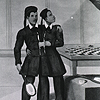
Marvels on Exhibit (15th through 18th-centuries)
Chang-Eng Bunker
Chang-Eng Bunker were born on May 11, 1811 to Chinese parents in Siam (Thailand). At the time their birth was viewed as a portent of disaster and the Siamese king Rama II initially ordered them put to death, before becoming convinced that the twins themselves were harmless. By their teens the twins had found favor with King Rama III, who showered them with gifts and even sent them on diplomatic missions. A British merchant, Robert Hunter, and American sea captain, Abel Coffin, convinced Rama III to allow the twins to go on a two and one-half year exhibition tour in America and England from 1829 to 1831. Shortly after this tour Chang-Eng took control of their career and earned a living as entertainers for the next four decades.
Touring the world, their stage presence, and their uniqueness made them famous in very little time. Many marveled at the thick, fleshy ligament, five to six inches long and eight inches in circumference, that connected them at the base of the chest. Despite the prevailing societal idea that conjoined twins were monstrous, inhuman beings, Chang-Eng became accepted and respected by society, and were often received by royalty.
At age 28 Chang-Eng settled down to be farmers in North Carolina, where they married the Yates sisters in 1843 and maintained separate households. The couple produced 21 children between the two families, though only 11 survived to maturity. Financial necessity compelled Chang-Eng to return to show business and make paid public appearances. In their later years, they often appeared with their children, which both piqued audience curiosity and demonstrated their humanity. On their return voyage from Russia in 1870, Chang became paralyzed from a stroke, which required Eng to support him physically for the remaining three years of their lives. Chang-Eng died on January 17, 1874, at the age of 62.
Autopsy Report on Chang-Eng
With the widows' permission, a detailed autopsy of Chang-Eng was conducted by Drs. William Pancoast and Harrison Allen in the Mütter Museum of the College of Physicians of Philadelphia from February 10-11, 1874. Shown below from the autopsy report, are a contemporary sketch of the bodies and a diagram illustrating the conjoined tissues and hepatic vessels of the connecting band. Given the shared hepatic vessels it is doubtful that a skilled 19th-century physician could have successfully separated the twins without causing the death of one twin.
Millie-Christine McCoy
"The Carolina Twins", Millie-Christine McCoy, were born in Columbus County, North Carolina, on July 11, 1851 as ordinary slaves. Both girls were remarkably healthy although Millie would always remain slightly smaller. Between the ages of 10 months and 6 years of age, the twins were sold at least three times (legally and illegally) and exhibited throughout the United States and England. Millie-Christine were frequently examined by physicians in the towns where they appeared to confirm that they were conjoined. The physicians were astonished to find a pair of conjoined twins of African American descent. They were described as interesting, intelligent people who had nothing of monstrosity in their appearance.
North Carolina merchant Joseph Pearson Smith purchased Millie-Christine's parents and family from the McCoys and his wife taught them how to read and write and sing and dance. They became fluent in five languages and were accomplished pianists, singers, and dancers who toured the world. They were frequently billed as "The Two-Headed Nightingale" after their beautiful singing voices. In 1869, the twins issued their autobiography, "History and Medical Description of the Two-Headed Girl," which was purchasable for $.25 at their public appearances.
After a successful thirty-plus year career, the sisters stopped performing in shows and retired to their home in North Carolina. In 1909 a fire destroyed all their possessions and they suffered great financial loss. The twins' health also began to decline. Millie contracted tuberculosis, which later affected Christine, and eventually claimed both their lives on October 8, 1912.
Physical examination of Millie-Christine
In 1871 while touring in Philadelphia, with Chang-Eng Bunker, Millie-Christine were sent to Dr. William Pancoast to be treated for an anal fistula. He published details of his examination, including photographs and sketches of their conjoined tissues in the Photographic Review of Medicine and Surgery. His examination confirmed what other physicians had already determined: Millie-Christine shared one vulva and one anus, but had separate urethras and bladders; the labia majora although connected to two clitorises, ran continuous across the vulva and protected but one vagina and one uterus. He characterized the band of their union as containing mostly cartilage with shared osseous tissue at the sacrum.
Last Reviewed: March 11, 2024










